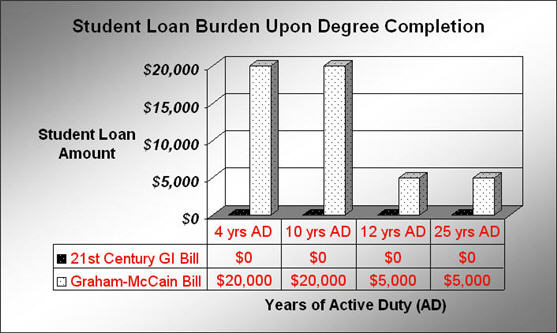
We have heard the opposition's argument against the 21st Century GI Bill time and time again:
At a time when the United States Military is fighting in two wars and we're finally, finally beginning the long overdue and very urgent necessity of increasing the size of the Army and Marine Corps. one study, one study estimates that Sen. Webb's bill will reduce retention rates by 16%.
--Sen. John McCain R-AZ
First, let's point out that the same study Sen. McCain cites also determined the 21st Century GI Bill (Sen. Webb's bill) would increase recruiting by 16%, thereby offsetting any reduction in retention (re-enlistment). But what do these percentages really mean? How many soldiers, sailors, airmen, and Marines are we talking about? The truth is the increase in recruiting represents a far greater number of troops than the decrease in retention; resulting in a net increase of our Armed Forces.
The Congressional Budget Office (CBO) categorizes troops eligible for re-enlistment into three categories: initial enlistment, mid-career, and careerists. The New GI Bill would mainly affect the retention of troops in their initial enlistment.
The following is a breakdown of the numbers based on most recent recruiting and retention statistics provided by the CBO for fiscal year (FY) 2000 through FY2005. There is more recent data on recruiting numbers, but no recent data for retention (FY2006 or FY2007). Thus, we will compare the averages for FY2000 through FY2005. It excludes data for the Air Force and Navy because they evaluate retention based on a percentage and not actual airmen and sailors. No matter, the Air Force and Navy are currently trying to reduce end strength of their respective branches.
Increased accessions in relation to decreased intitial enlistee retention:

It should be noted that two entire branches of service were left out of these calculations. So the increase in troops would be even larger than 13,000 per year. But wait, there's more (from the CBO):
According to CBO's estimates, as a rule of thumb, each increase of 1,000 in annual accessions (maintained over a five-year period) would accumulate to boost end strength by more than 3,000 additional personnel by the end of the fifth year.
Based on this rule the 21st Century GI Bill would increase the end strength of our Armed Forces more than 39,000 troops, and considering the Navy and Air Force were left out; one could easily assume this increase would be in excess of 50,000 additional troops. The 21st Century GI Bill is a sound means to increase the end strength of our Armed Forces. Furthermore, at a time when only 79% of new Army recruits possess a diploma and 13% of new recruits were granted criminal background waivers; the 21st Century GI Bill is the ideal mechanism to increase the quality of new recruits.
In a recent Army Times article unrelated to the 21st Century GI Bill titled: Have recruit incentives reached their limit? Lawrence Kapp, a military manpower analyst with the Congressional Research Service stated:
There has to be some way of re-connecting service, broadly speaking, with kind of the white-collar expectations of many of our youth today
David S.C. Chu, Undersecretary of Defense for Personnel and Readiness who was also featured in the article stated:
In order to increase the pool of best-quality recruits...the military must make itself attractive to young Americans...the military cannot reverse course on its standards. The military strives to recruit individuals with a high aptitude for service and a high level of personal behavior.
Lastly, Heidi Goldberg, a CBO analyst noted:
she would place more emphasis on the college "market." Recruiters tend to focus on the high school market, she said, but "many people who begin college don't complete it."
The evidence speaks for itself. The 21st Century GI Bill is the modern solution to today's recruiting demands and fulfills a much needed niche in society; bridging the gap between secondary education and institutions of higher learning. It is apparent that the current GI Bill is outdated and must be replaced in order to keep pace with the rapid social changes occuring in our society.
In contrast to recruiting, it has been argued that the 21st Century GI Bill will cause the Armed Forces to lose a disproportionate number of mid-level experience troops known as non-commissioned officers (NCOs) due to the increased education benefits. NCOs typically fall into the category of "initial enlistment" because they are on their first contract and have served less than 10 years. Fortunately, the CBO also determined the minor reduction in retention could be offset by a re-enlistment bonus of $25,000 to troops at the end of their first enlistment. It's worth mentioning that potential recruits are currently offered up to $40,000 in enlistment bonuses. Also worth mentioning is a document released by the Marine Corps. in 2007 concerning retention:
The Marine Corps endeavors to attain and maintain stable retention patterns. However, lucrative civilian employment opportunities abound for Marines and challenge the retention of critical skills.
What is more damaging to retention? $90,000 over four years that can only be used for an education and room & board, or $100,000 cash from a private contractor? It's obvious from the statement released by the Marine Corps. that the real problem facing retention of experienced NCOs is lucrative civilian employment opportunities.
Additionally, opponents of the 21st Century GI Bill proclaim that education benefits must be transferable to dependents. Sponsors of competing GI Bill legislation, Senators Graham R-SC and McCain, point out that the Graham-McCain bill provides transferability of 50% of benefits after six years and 100% of benefits after twelve years to dependents, while the 21st Century GI Bill does not provide this important transferability. Fortunately, Sen. Warner has agreed to amend the 21st Century GI Bill to provide transferability to dependents. Sen. Akaka D-HI, a skeptic of transferability who supports the 21st Century GI Bill added:
I have consistently stated that I believe that transferability can be an important retention tool for the military, especially the option of offering transferability to those veterans that the military needs to retain for longer periods of time.
Proponents of the Graham-McCain bill also believe the educational benefits should be tied to a sliding-scale as Sen. McCain points out:
The most important difference between our two approaches is that Senator Webb offers veterans who served one enlistment the same benefits as those offered veterans who have re-enlisted several times. Our bill has a sliding scale that offers generous benefits to all veterans, but increases those benefits according to the veteran's length of service.
Unfortunately, the sliding-scale established in the Graham-McCain bill does not properly adjust to compensate mid-career re-enlistees (those with less than 10 yrs length of service) as is illustrated below:

Click the GI's Guide for the New GI Bills for references and to see how these figures were determined.
This fact could lead to a large number of experienced NCOs separating from the Armed Forces; due to the extended length of time until a service member would be eligible for additional benefits: an additional 8 years. One could argue that the marginal $15,000 increase in educational benefits may not be enough to justify serving in the Armed Forces for an additional 8 years for some service members. Especially for service members who are focused on attending college.
Lastly, the difference in the amount of education benefits between the 21st Century GI Bill and the Graham-McCain bill has been questioned by some. During a recent televised interview with CBS Face the Nation host, Bob Schieffer; Sen. Graham characterized the 21st Century GI Bill as a benefit that would:
give $52 billion to the people who will leave the military and nothing for those who will stay
The chart above clearly shows which bill would properly reward our service members who serve a career in the Armed Forces. And it leaves no question about which bill would give "nothing for those who will stay" for a career in the military.
In conclusion, the 21st Century GI Bill has the support of every major veteran's service organization for good reason. It would not only help increase the end strength of our Armed Forces but it would also reward the service of our nation's veterans who have sacrificed the most for America. Our nation's veterans deserve a first class education; an education without the financial and economic burden of the "ball & chain" of student loans.
The views expressed in this article are solely those of the author and not those of the Department of Defense or the United States Marine Corps.